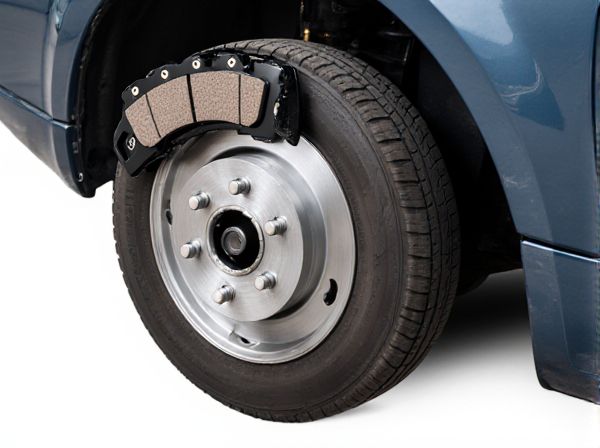
Photo illustration: Organic Pad vs Ceramic Pad
Organic pads offer excellent initial bite and are quieter, making them ideal for everyday driving and lighter vehicles. Ceramic pads provide longer durability, less brake dust, and superior heat resistance, enhancing performance under heavy braking conditions. Your choice depends on whether you prioritize comfort and noise reduction or longevity and high-temperature performance.
Table of Comparison
| Feature | Organic Brake Pads | Ceramic Brake Pads |
|---|---|---|
| Material Composition | Resin, rubber, and glass fibers | Ceramic fibers with bonding agents |
| Noise Level | Moderate to high noise | Low noise, quieter braking |
| Dust Production | Higher dust, darker residue | Low dust, cleaner wheels |
| Durability | Moderate lifespan | Longer lifespan, more wear-resistant |
| Performance | Good for everyday driving | Superior performance in high temperatures |
| Cost | Lower cost | Higher cost |
| Best Use | City driving, light braking | Performance cars, heavy braking |
Introduction to Brake Pads
Organic pads, made from a mixture of fibers, resins, and fillers, provide quieter braking and gentle wear on rotors, making them suitable for everyday driving. Ceramic pads contain ceramic fibers and bonding agents, offering superior heat dissipation, longer lifespan, and reduced brake dust compared to organic pads. Both types serve essential roles in vehicle braking systems, with ceramic pads often preferred for high-performance applications due to their stability under extreme conditions.
What Are Organic Brake Pads?
Organic brake pads consist of a mixture of fibers, fillers, and bonding resins, often incorporating materials like rubber, glass, and Kevlar for enhanced performance. These pads are softer than ceramic counterparts, offering quieter braking with less rotor wear but typically shorter lifespan and increased dust production. Organic brake pads excel in low-speed driving and provide a more environmentally friendly option due to their non-metallic composition.
What Are Ceramic Brake Pads?
Ceramic brake pads are composed of dense ceramic fibers, nonferrous filler materials, and bonding agents, offering superior heat resistance and reduced brake dust compared to organic pads. They provide quieter braking performance and longer lifespan due to their stable material composition under high temperatures. Ceramic pads also deliver consistent stopping power, making them ideal for everyday driving conditions where low noise and minimal rotor wear are priorities.
Performance Comparison: Organic vs Ceramic
Organic brake pads deliver excellent initial bite and quieter operation due to their natural fiber composition, making them ideal for daily driving and low-speed conditions. Ceramic pads offer superior heat dissipation and longer lifespan, ensuring consistent braking performance and reduced brake dust under high-stress or high-temperature environments. The choice between organic and ceramic depends on driving style, with ceramic pads excelling in performance and durability, while organic pads prioritize comfort and noise reduction.
Durability and Lifespan Differences
Organic brake pads offer good initial bite and quieter operation but wear out faster due to softer materials, typically lasting around 20,000 to 40,000 miles. Ceramic brake pads, made from dense ceramic compounds and copper fibers, provide superior durability with a longer lifespan of 40,000 to 70,000 miles, maintaining consistent performance under high heat. The enhanced thermal stability of ceramic pads reduces wear and brake dust, making them a more cost-effective choice over time for drivers prioritizing longevity.
Noise and Dust Levels
Organic brake pads produce less noise due to their softer friction materials but tend to generate more dust that can accumulate on wheels. Ceramic brake pads offer quieter braking performance with minimal dust production, as their dense ceramic compounds resist wear and reduce residue. Vehicles using ceramic pads benefit from cleaner wheels and reduced noise pollution compared to those fitted with organic pads.
Cost and Value Analysis
Organic brake pads generally have a lower upfront cost compared to ceramic pads, making them more budget-friendly for everyday driving needs. However, ceramic pads offer longer lifespan and better performance under high heat, providing greater value over time despite their higher initial price. Evaluating total ownership cost, ceramic pads often result in fewer replacements and reduced wear on rotors, enhancing overall cost-effectiveness.
Environmental Impact of Pad Materials
Organic brake pads are typically made from natural fibers, resins, and fillers, resulting in lower environmental impact due to their biodegradable and non-toxic composition. In contrast, ceramic pads contain synthetic materials such as ceramic fibers and inorganic compounds, which offer durability but may pose challenges in disposal and produce fewer harmful particulates during use. Choosing organic pads supports reduced pollution and waste, aligning with eco-friendly automotive maintenance practices.
Best Applications for Organic and Ceramic Pads
Organic brake pads offer superior performance in everyday driving conditions, providing smooth and quiet braking ideal for city commutes and light vehicles. Ceramic brake pads excel under high-temperature conditions, making them well-suited for performance cars, trucks, and SUVs requiring durable stopping power and reduced brake dust. Choosing between organic and ceramic pads depends on the vehicle type, driving style, and desired balance between comfort and performance.
How to Choose the Right Brake Pad for Your Vehicle
Choosing the right brake pad for your vehicle involves evaluating performance needs, driving conditions, and budget, with organic pads offering quieter operation and softer braking for everyday driving, while ceramic pads provide longer durability, less dust, and enhanced stopping power ideal for high-performance or heavy-duty use. Consider factors such as vehicle type, typical driving environment, and personal preferences to balance comfort, longevity, and braking efficiency. Consult manufacturer recommendations and expert reviews to ensure compatibility and optimal safety with your vehicle's braking system.
 caratoz.com
caratoz.com